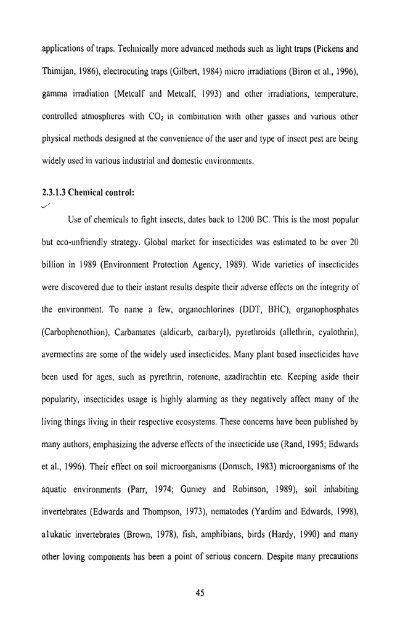Download (26Mb) - OAR@ICRISAT
Download (26Mb) - OAR@ICRISAT
Download (26Mb) - OAR@ICRISAT
Create successful ePaper yourself
Turn your PDF publications into a flip-book with our unique Google optimized e-Paper software.
applications of traps. Technically more advanced lllethods such as light traps (Pickens and<br />
Thimijan, 1986), electrocuting traps (Gilben, 1984) micro ii~adiatiolls (Biron ct al., 1996),<br />
gamma irradiation (Metcalf atid Metcalf, 1993) and otlier irradiations, temperature,<br />
coiltrolled atmospheres with COi ~n combination w~th other gasses and varlous othcr<br />
physical methods designed at the coliverilelice of the user and (ype of insect pest are being<br />
widely used In various industr~ol and domestic envll.onmcnts.<br />
2.3.1.3 Cl~e~~~icill colitrol:<br />
., '<br />
Use of chemicals to fight Insects, dates back to 1200 BC. This is thc most popular<br />
but cco-unfr~tndly strategy. Global market for insect~cides was estilnated to be over 20<br />
billion in 1989 (Environnlent Protection Agency, 1989). Wide varietics of i~isecticidcs<br />
were discovered due to the~r instant resul~s despite their adverse effects on thc ~ntegrity of<br />
the ellviron~iient. To name a few, orga~ioclilorilles (DDT, BHC), orgaliopliosphatcs<br />
(Carbophenothion), Carbarnates (aldicarb, carburyl), pyretliroids (nllethrin, cyalotllrill),<br />
averniectins are some of the widely used insecticldes. Many plant based insecticides have<br />
been used for ages, such as pyrethrin, rotenone, azadirachtin etc. Keeping as~de their<br />
popularity, ~nsect~c~des usage is highly alarnling as they negat~vely affect many of the<br />
living things living in their respective ecosystems. These concerns have bccn published by<br />
many authors, emphasizing the adverse eficts of the insecticide use (Rand, 1995; Edwards<br />
et al., 1996). Their effect on soil microorganisms (Domsch, 1983) microorganisms of the<br />
aquatic environments (Parr, 1974; Curlley and Robinson,<br />
1989), soil inhabiting<br />
invertebrates (Edwards acid Thompson, 1973), liematodes (Yardim and Edwards, 1998),<br />
alukatic invertebrates (Brown, 1978), fish, amphibians, birds (Hardy, 1990) and many<br />
other loving components has been a point of serious concern. Despite many precautions
















